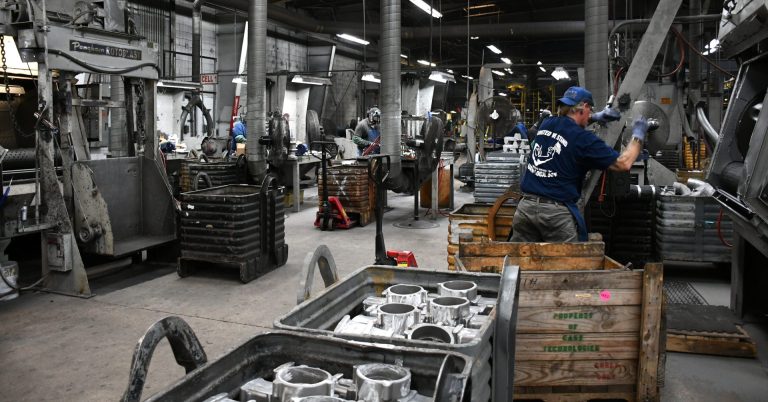Aluminum Casting Illinois: Unrivaled Toughness, Unbeatable Costs
Aluminum Casting Illinois: Unrivaled Toughness, Unbeatable Costs
Blog Article
The Ultimate Light Weight Aluminum Casting Handbook: Step-by-Step Directions for Success

Safety Preventative Measures for Light Weight Aluminum Casting

Additionally, keeping a neat workspace devoid of mess can protect against tripping risks and help with the motion of personnel during casting processes. aluminum casting illinois. Proper training in dealing with molten light weight aluminum and operating casting devices is important to decrease the risk of crashes and injuries. Routine equipment maintenance and examination ought to be performed to identify and remedy any prospective safety and security hazards immediately
Establishing Your Aluminum Casting Work Space
Developing a safe and effective workspace for aluminum spreading is critical for making certain smooth procedures and reducing possible threats. Prior to setting up your workspace, ensure that it is well-ventilated to protect against the build-up of hazardous fumes produced during the spreading process. It is necessary to have actually a designated location for each phase of the casting procedure, such as pattern making, mold and mildew preparation, and steel putting, to enhance workflow and protect against cross-contamination.
Choosing the Right Aluminum Alloy
To make certain optimal spreading results in your safety-focused and well-organized office, selecting the proper aluminum alloy is paramount. Different light weight aluminum alloys offer different characteristics such as stamina, longevity, warm resistance, and machinability. The selection of alloy depends upon the details requirements of your casting job.
One generally used light weight aluminum alloy for spreading is A356. This alloy displays excellent fluidity, making it optimal for detailed castings with thin wall surfaces. A356 additionally has excellent rust resistance and mechanical homes, making it ideal for a wide variety of applications.
If greater toughness is required, 7075 light weight aluminum alloy is a preferred choice. Understood for its high strength-to-weight ratio, 7075 is usually used in applications where strength is essential, such as aerospace elements.
For tasks that entail high-temperature settings, 319 light weight aluminum alloy is a good option due to its remarkable thermal conductivity and resistance to thermal breaking.

Step-by-Step Aluminum Spreading Refine
Commencing the light weight aluminum casting procedure entails precise prep work and adherence to a directory precise collection of steps to make sure the manufacturing of top quality spreadings. This pattern is then used to produce the mold and mildew, which can be made of products like sand or plaster.
After getting to the desired temperature, the liquified aluminum is poured right into the mold and mildew dental caries. This action requires care and accuracy to avoid defects in the final casting. The aluminum is left to strengthen and cool inside the mold prior to it is removed for finishing. Post-processing strategies such as grinding, fining sand, and warmth therapy might be used to attain the wanted shape, surface area finish, and mechanical homes.
Throughout the whole procedure, mindful tracking and quality assurance steps should be applied to make sure the final aluminum spreading fulfills the needed requirements and requirements.
Tips for Developing Your Casting Method
In refining your aluminum casting method, meticulous interest to detail and adherence to exact actions are vital to making sure the manufacturing of high-quality castings. One critical tip for developing your casting technique is to thoroughly prepare the mold and mildew and guarantee it is tidy and appropriately covered with a release agent to aid in the very easy removal of the spreading. In addition, preserving the light weight aluminum at the right temperature level throughout the spreading process is essential for accomplishing optimal circulation and minimizing the risk of issues. Another pointer is to put the liquified light weight aluminum gradually and gradually right into the mold and mildew to stop air entrapment and make sure home a smooth fill. It is likewise essential to permit adequate time for the light weight aluminum to solidify completely before removing the casting from the mold. Lastly, evaluating the casting for any imperfections and making required modifications to the process will aid you enhance and ideal your aluminum casting method with time.
Verdict
In final thought, complying with proper safety precautions, setting up an appropriate work space, selecting the proper aluminum alloy, and diligently complying with the detailed spreading procedure are essential for effective light weight aluminum casting. By focusing on these crucial variables and integrating ideas to improve your technique, you can attain exceptional results in your light weight aluminum casting projects.
From security precautions to perfecting casting methods, this handbook offers as a sign of expertise for those venturing into the globe of light weight aluminum spreading.
Beginning the aluminum casting process entails careful preparation and adherence to an exact collection of actions to ensure the manufacturing of top quality spreadings.In refining your light weight aluminum spreading technique, meticulous click reference interest to detail and adherence to specific steps are paramount to ensuring the production of high-quality castings. One vital suggestion for refining your casting technique is to carefully prepare the mold and guarantee it is clean and correctly coated with a release agent to help in the very easy removal of the spreading. Examining the spreading for any blemishes and making needed modifications to the process will aid you boost and best your light weight aluminum casting strategy over time.
Report this page